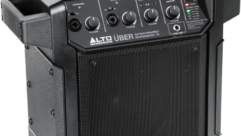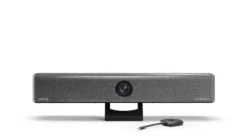Newly developing technology and a shrinking operational RF spectrum have increasingly transformed the wireless microphone arena into a very dynamic landscape. While manufacturers try to deal with spectrum challenges, system designers are continuously employing new ways of achieving more reliable performance and ease of use. As with other technical gear, wireless microphones work best when the right system is matched to the exact task. Surveyed here are the results of current technology and design.
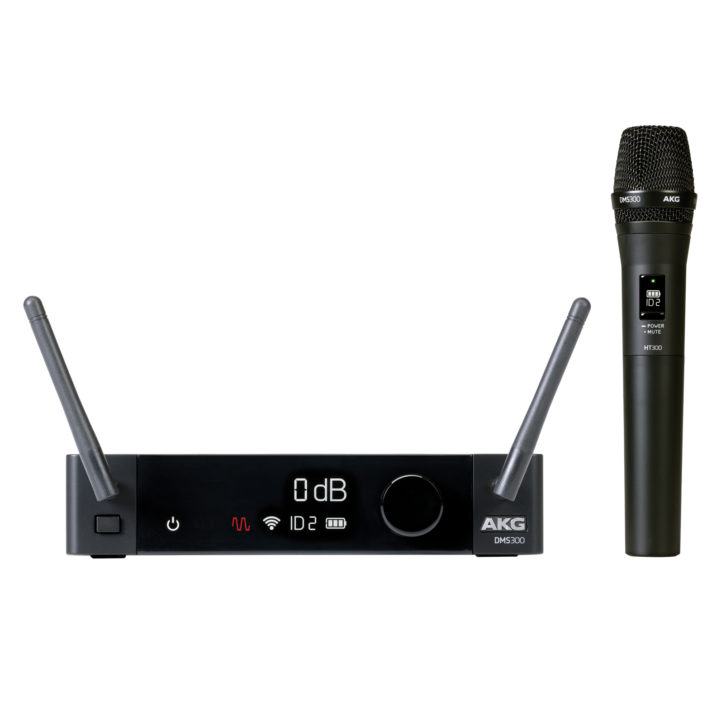 A proven performer, the AKG DMS300 is light and easy to set up for vocalists, lecturers, churches and tour guides. The front panel features an LCD display that shows channel number, signal strength, and battery level. The system operates in the 2.4Ghz band that is globally license free so that users don’t have to keep up with new spectrum allocations. As many as eight systems can be operated together while adaptive channel selection makes it effortless to get around busy or interfering local channels. The handheld transmitter provides 24-bit, 48kHz digital resolution and linear frequency response. AES 256-bit encryption assures signal security. The bodypack transmitter can be used with headset or lapel microphones or it can be instrument connected. The transmitters can operate for up to 12 hours on two AA batteries.
A proven performer, the AKG DMS300 is light and easy to set up for vocalists, lecturers, churches and tour guides. The front panel features an LCD display that shows channel number, signal strength, and battery level. The system operates in the 2.4Ghz band that is globally license free so that users don’t have to keep up with new spectrum allocations. As many as eight systems can be operated together while adaptive channel selection makes it effortless to get around busy or interfering local channels. The handheld transmitter provides 24-bit, 48kHz digital resolution and linear frequency response. AES 256-bit encryption assures signal security. The bodypack transmitter can be used with headset or lapel microphones or it can be instrument connected. The transmitters can operate for up to 12 hours on two AA batteries.
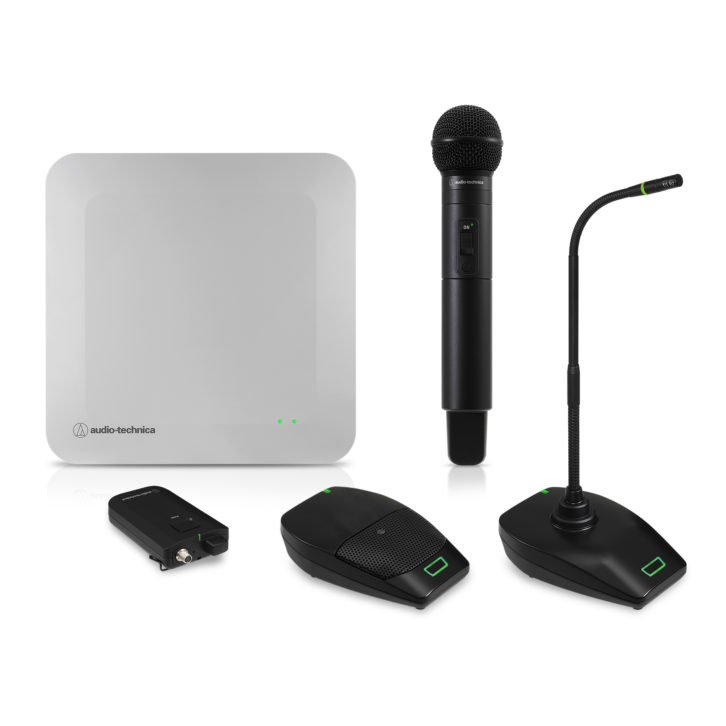 The Audio-Technica Engineered Sound Wireless (ESW) has recently been released to respond to needs for better frequency coordination and conferencing solutions. This is a DECT-based system and the receivers have PoE and Dante audio outputs. For big setups it is scalable up to 96 channels with each receiver connected by Cat 5e to a PoE network switch. AES 256-bit encryption is builtin. Based on the ESW-R4180DAN 8-channel Dante-enabled receiver, the system can include the ESW-T4101 bodypack with an integrated microphone, ESW-T4102/C510 handheld, ESW-T4106 boundary microphone, and ESWT4107 desk stand. Lithium-ion batteries keep the transmitters going all day and when it’s time to tank them up again there are the ESWCHG4 two-bay bodypack and handheld charging station and the ESW-CHG5 four-bay desk stand and boundary charging station.
The Audio-Technica Engineered Sound Wireless (ESW) has recently been released to respond to needs for better frequency coordination and conferencing solutions. This is a DECT-based system and the receivers have PoE and Dante audio outputs. For big setups it is scalable up to 96 channels with each receiver connected by Cat 5e to a PoE network switch. AES 256-bit encryption is builtin. Based on the ESW-R4180DAN 8-channel Dante-enabled receiver, the system can include the ESW-T4101 bodypack with an integrated microphone, ESW-T4102/C510 handheld, ESW-T4106 boundary microphone, and ESWT4107 desk stand. Lithium-ion batteries keep the transmitters going all day and when it’s time to tank them up again there are the ESWCHG4 two-bay bodypack and handheld charging station and the ESW-CHG5 four-bay desk stand and boundary charging station.
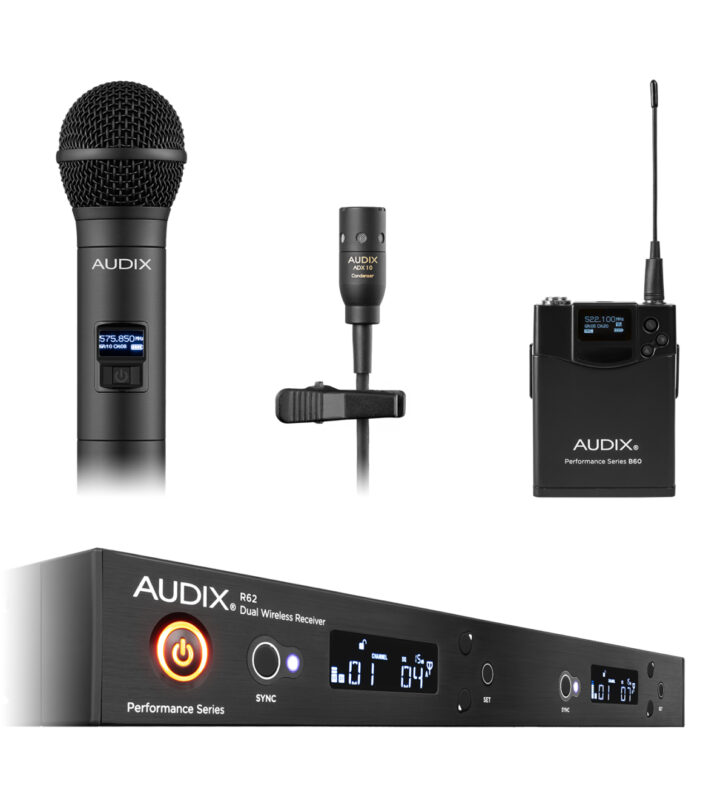 Professionals can rely on the two-channel UHF true diversity Audix AP62 C210 for reliable operation in demanding environments whether the receiver is in stand-alone or rack mounted configuration. In rack mount mode, there is a kit that enables the antennas to be front mounted on the R62 receiver and two of the receivers can be mounted in a single rack space. The 64Mhz wide spectrum transmitter H60 OM2 has a tough, metal case that can deal with hard road use and the B60 L10 bodypack transmitter is just as sturdy. Both have an approximate 14-hour run time on AA batteries. Capable of 2560 tunable frequencies, the receiver has one-touch auto scan for easily locating clear channels and its one-touch linking feature syncs up the transmitter via infrared.
Professionals can rely on the two-channel UHF true diversity Audix AP62 C210 for reliable operation in demanding environments whether the receiver is in stand-alone or rack mounted configuration. In rack mount mode, there is a kit that enables the antennas to be front mounted on the R62 receiver and two of the receivers can be mounted in a single rack space. The 64Mhz wide spectrum transmitter H60 OM2 has a tough, metal case that can deal with hard road use and the B60 L10 bodypack transmitter is just as sturdy. Both have an approximate 14-hour run time on AA batteries. Capable of 2560 tunable frequencies, the receiver has one-touch auto scan for easily locating clear channels and its one-touch linking feature syncs up the transmitter via infrared.
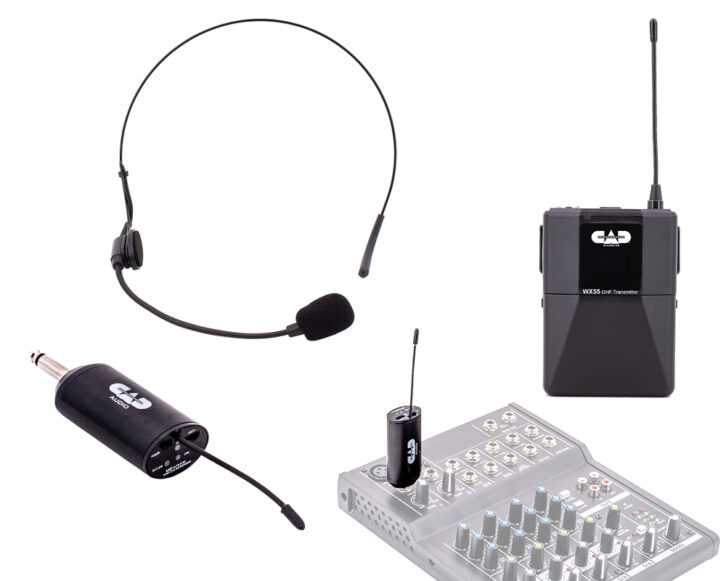 Billed as a digital frequency agile bodypack wireless system, the CAD Audio WX55 delivers top wireless mic technology to the masses. It is perfect for lecturers, corporate presentations, small churches and many other applications. With an audio frequency response of 20Hz to 16kHz, the mic transmits on the bodypack in the 500Mhz – 599Mhz range, and within that range it can be operated on 16 different channels. As many as 15 systems can be simultaneously used and the transmitters can range up to 164ft. from the receivers. The QuickMic connection uses a 1/4in. connector for use with small mixers. The transmitters can run for over 8 hours on two AA batteries and there are low battery indicators on them as well as on the receivers.
Billed as a digital frequency agile bodypack wireless system, the CAD Audio WX55 delivers top wireless mic technology to the masses. It is perfect for lecturers, corporate presentations, small churches and many other applications. With an audio frequency response of 20Hz to 16kHz, the mic transmits on the bodypack in the 500Mhz – 599Mhz range, and within that range it can be operated on 16 different channels. As many as 15 systems can be simultaneously used and the transmitters can range up to 164ft. from the receivers. The QuickMic connection uses a 1/4in. connector for use with small mixers. The transmitters can run for over 8 hours on two AA batteries and there are low battery indicators on them as well as on the receivers.
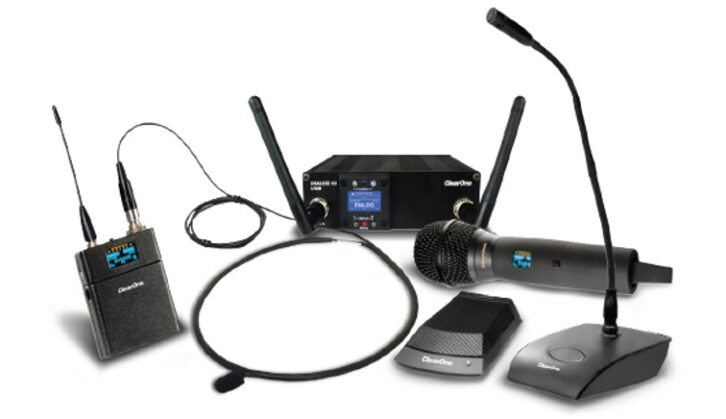 The ClearOne Dialog 10 USB puts a professional quality wireless system on a USB connector so users can connect a USB Type C cable to a PC for audio, power, and control. Once the Auto-scan feature has selected a clear channel, the receiver can integrate with Dante Via for a sound reinforcement system. Content is secure through FIPS 197 AES-128 encryption and the receiver’s large, color LCD shows battery life, received signal strength, and the programmable microphone ID label. Depending on the specific environment and type of use, the transmitter can be a handheld unit, boundary mic, gooseneck mic or the beltpack transmitter can be used with a headset or lapel microphone. This setup works on frequency-hopping spread spectrum technology with no frequency license restrictions worldwide.
The ClearOne Dialog 10 USB puts a professional quality wireless system on a USB connector so users can connect a USB Type C cable to a PC for audio, power, and control. Once the Auto-scan feature has selected a clear channel, the receiver can integrate with Dante Via for a sound reinforcement system. Content is secure through FIPS 197 AES-128 encryption and the receiver’s large, color LCD shows battery life, received signal strength, and the programmable microphone ID label. Depending on the specific environment and type of use, the transmitter can be a handheld unit, boundary mic, gooseneck mic or the beltpack transmitter can be used with a headset or lapel microphone. This setup works on frequency-hopping spread spectrum technology with no frequency license restrictions worldwide.
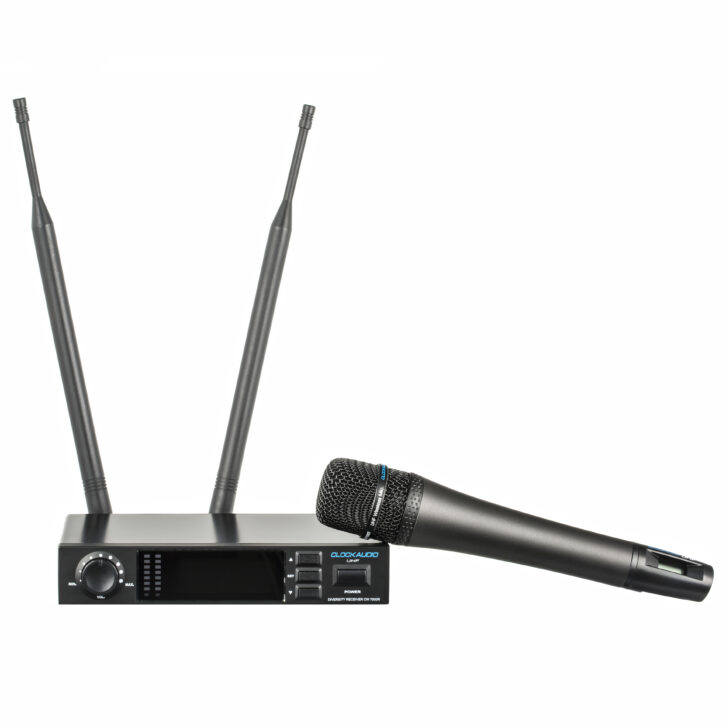 Having served in a huge variety of performance and conferencing environments, the ClockAudio CW7000 UHF PLL Personal Wideband True Diversity System includes the CW 7000T handheld microphone transmitter and the CW 7000R receiver. Operating in the 502-960MHz band, the mic and receiver provide users with a choice of 1441 selectable frequencies while the two built-in independent RF receivers ensure stable reception. Pilot tone squelch avoids ambient RF noise reception when the mic is turned off. The receiver produces audio on a balanced output with 3-pin XLR or a 1/4in. jack. On the transmitter end, RF output power is switchable between 10mW and 50mW. The mic’s frequency response is 50Hz to 16.5kHz and it can operate for 12 hours at 10mW and 7 Hours at 50mW.
Having served in a huge variety of performance and conferencing environments, the ClockAudio CW7000 UHF PLL Personal Wideband True Diversity System includes the CW 7000T handheld microphone transmitter and the CW 7000R receiver. Operating in the 502-960MHz band, the mic and receiver provide users with a choice of 1441 selectable frequencies while the two built-in independent RF receivers ensure stable reception. Pilot tone squelch avoids ambient RF noise reception when the mic is turned off. The receiver produces audio on a balanced output with 3-pin XLR or a 1/4in. jack. On the transmitter end, RF output power is switchable between 10mW and 50mW. The mic’s frequency response is 50Hz to 16.5kHz and it can operate for 12 hours at 10mW and 7 Hours at 50mW.
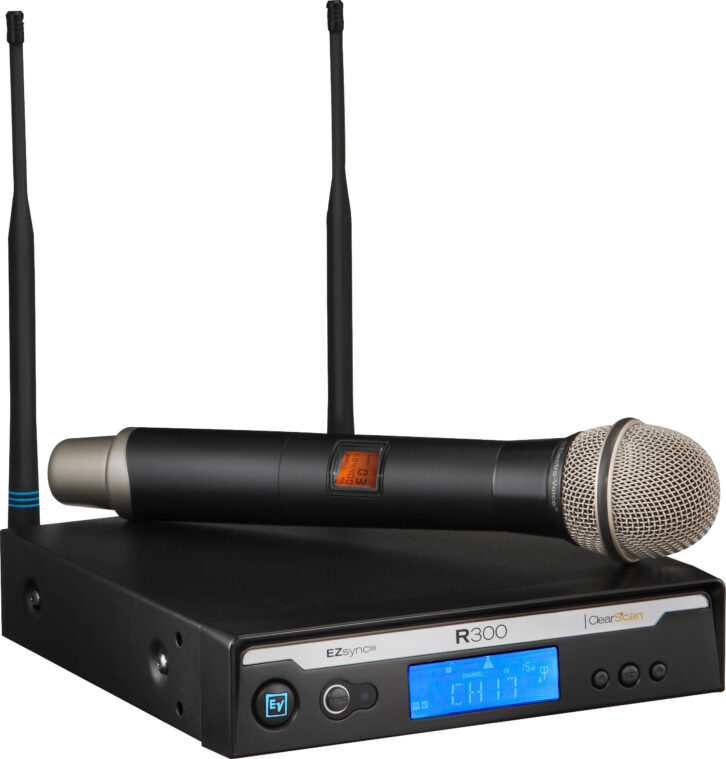 Another very capable handheld transmitter wireless system is the Electro-Voice R300-HD with its durable metal case. The cardioid polar pattern on the PL22 dynamic microphone allows more gain before feedback in high sound reinforcement scenarios. The hard cased receiver can be table or rack mounted and it can be used on any of 32 channels in the 618MHz-865MHz frequency band. The unit features both balanced and unbalanced audio outputs. The mic has a frequency response of 80Hz to 18kHz (±2dB) for full bodied sound. A pair of AA batteries will keep it going for up to 14 hours with a typical 8mW RF output. ClearScan automatically finds a clear channel and EZsync allows one-step channel setup between mic and receiver.
Another very capable handheld transmitter wireless system is the Electro-Voice R300-HD with its durable metal case. The cardioid polar pattern on the PL22 dynamic microphone allows more gain before feedback in high sound reinforcement scenarios. The hard cased receiver can be table or rack mounted and it can be used on any of 32 channels in the 618MHz-865MHz frequency band. The unit features both balanced and unbalanced audio outputs. The mic has a frequency response of 80Hz to 18kHz (±2dB) for full bodied sound. A pair of AA batteries will keep it going for up to 14 hours with a typical 8mW RF output. ClearScan automatically finds a clear channel and EZsync allows one-step channel setup between mic and receiver.
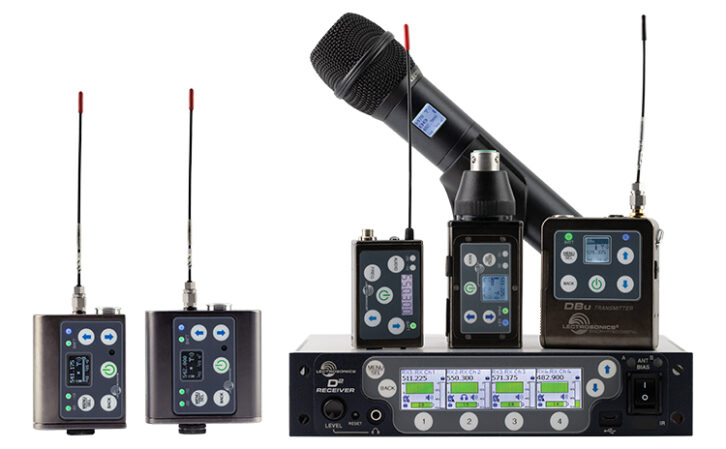 The Lectrosonics D2 digital wireless microphone platform is a professional’s favorite featuring high quality audio, fast setup, 24 bit/48 kHz digital conversion, analog and digital outputs, and ultra-low latency. The system is comprised of the DSQD 4-channel digital receiver, DBu digital beltpack transmitter, DPR and DPR-A digital plug-on transmitters, and the DHu digital handheld transmitter. For sound quality, this model has an exeptional frequency response of 25Hz to 20kHz (±1dB), and a dynamic range of 110dB. From transmitter input to receiver audio output the latency is only 1.4ms. There is also a TalkBack feature with select transmitter models. The receiver’s front panel features a full color, backlit LCD display that shows a range of parameters including frequency, channel number, and transmitter battery level.
The Lectrosonics D2 digital wireless microphone platform is a professional’s favorite featuring high quality audio, fast setup, 24 bit/48 kHz digital conversion, analog and digital outputs, and ultra-low latency. The system is comprised of the DSQD 4-channel digital receiver, DBu digital beltpack transmitter, DPR and DPR-A digital plug-on transmitters, and the DHu digital handheld transmitter. For sound quality, this model has an exeptional frequency response of 25Hz to 20kHz (±1dB), and a dynamic range of 110dB. From transmitter input to receiver audio output the latency is only 1.4ms. There is also a TalkBack feature with select transmitter models. The receiver’s front panel features a full color, backlit LCD display that shows a range of parameters including frequency, channel number, and transmitter battery level.
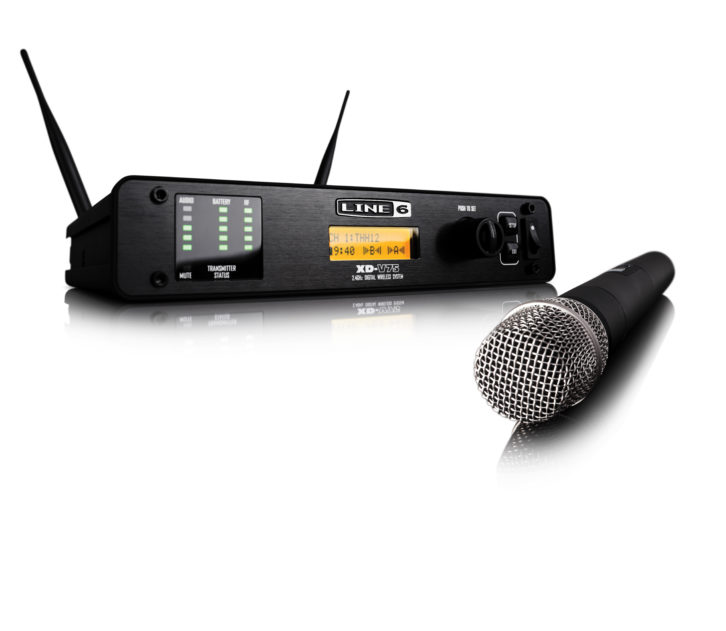 Another system that works up in the 2.4GHz ISM band and one that uses encoded DCLTM (Digital Channel Lock) technology is the Line 6 XD-V wireless mic system. This feature helps shield the signals from other types of RF traffic in the ISM band. For the larger applications, up to 14 XD-V systems can be used together. The large 5-segment LED screen on the XD-V75 receiver makes it easy to see the channel setup, monitor RF and view battery power level with automatic scanning to find the clear frequencies. Relay G30, G50, G55 and XD-V35, XD-V55 and XD-V75 systems all work together so handheld, headset and lapel mics along with instruments can be used to suit the show. Antenna signal distribution accessories are also available for the XD-V system.
Another system that works up in the 2.4GHz ISM band and one that uses encoded DCLTM (Digital Channel Lock) technology is the Line 6 XD-V wireless mic system. This feature helps shield the signals from other types of RF traffic in the ISM band. For the larger applications, up to 14 XD-V systems can be used together. The large 5-segment LED screen on the XD-V75 receiver makes it easy to see the channel setup, monitor RF and view battery power level with automatic scanning to find the clear frequencies. Relay G30, G50, G55 and XD-V35, XD-V55 and XD-V75 systems all work together so handheld, headset and lapel mics along with instruments can be used to suit the show. Antenna signal distribution accessories are also available for the XD-V system.
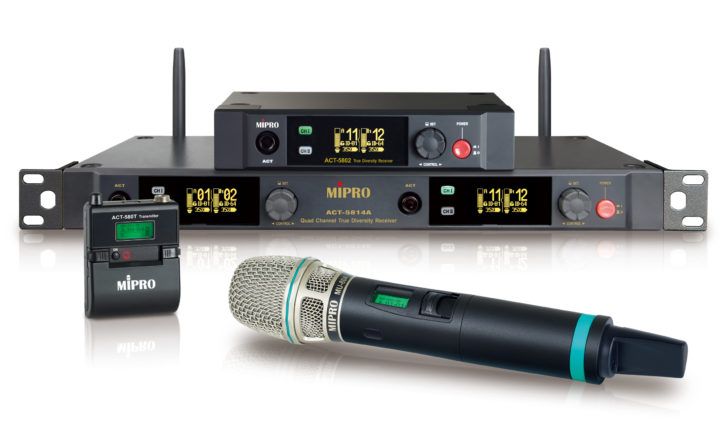 One particularly tricky combination to achieve for wireless product designers has been versatility with low cost but a consistent performer in this regard has been the Mipro ACT-5800 Series 5GHz true diversity wireless system with Auto Scan and the ACT feature for rapid transmitter-receiver sync. There are 12 channels in Group A along with 24 channels in Group B1 and B2. The antenna connectors carry RF and a DC voltage to power antenna amplifiers. The external AC 100-240 V switching power supply assures reliable power even in unstable voltage environments. The ACT5814A/5812As receiver work with the ACT580H handheld and ACT-580T bodypack transmitters and they have TNC output connectors that can be daisy-chained for up to three receivers. The half-rack receiver size allows maximum use of rack space.
One particularly tricky combination to achieve for wireless product designers has been versatility with low cost but a consistent performer in this regard has been the Mipro ACT-5800 Series 5GHz true diversity wireless system with Auto Scan and the ACT feature for rapid transmitter-receiver sync. There are 12 channels in Group A along with 24 channels in Group B1 and B2. The antenna connectors carry RF and a DC voltage to power antenna amplifiers. The external AC 100-240 V switching power supply assures reliable power even in unstable voltage environments. The ACT5814A/5812As receiver work with the ACT580H handheld and ACT-580T bodypack transmitters and they have TNC output connectors that can be daisy-chained for up to three receivers. The half-rack receiver size allows maximum use of rack space.
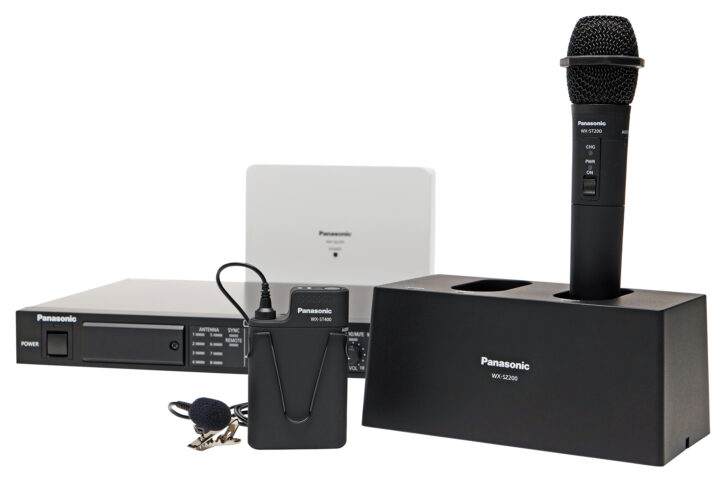 Whether the mission is conferencing, performance, church services or lecturing, thee Panasonic WX Series 1.9GHz digital wireless microphone system can be purchased and configured to get the job done. Based on either the WX-SR202DN 2-channel receiver or the WX-SR204 4-channel model, the system consists of the WM-KG645 18-inch gooseneck microphone with its WX-ST600 wireless base transmitter, the WX-ST700 wireless boundary mic, WX-SM410 lavalier microphone, WX-ST200 wireless handheld microphone, and the WX-ST400 lavalier microphone plus wireless bodypack. These are all supported by the WX-SZ200 desktop charging station, WX-SA250 wireless antenna, and WXSR200P-OS Operations Support Software. All of the receiver and microphone elements may be used in any combination for the specific environment. Also available is the WXSE200DN Dante expansion receiver which allows the user to add up to 4 additional wireless microphone channels to an existing Panasonic 4-channel system.
Whether the mission is conferencing, performance, church services or lecturing, thee Panasonic WX Series 1.9GHz digital wireless microphone system can be purchased and configured to get the job done. Based on either the WX-SR202DN 2-channel receiver or the WX-SR204 4-channel model, the system consists of the WM-KG645 18-inch gooseneck microphone with its WX-ST600 wireless base transmitter, the WX-ST700 wireless boundary mic, WX-SM410 lavalier microphone, WX-ST200 wireless handheld microphone, and the WX-ST400 lavalier microphone plus wireless bodypack. These are all supported by the WX-SZ200 desktop charging station, WX-SA250 wireless antenna, and WXSR200P-OS Operations Support Software. All of the receiver and microphone elements may be used in any combination for the specific environment. Also available is the WXSE200DN Dante expansion receiver which allows the user to add up to 4 additional wireless microphone channels to an existing Panasonic 4-channel system.
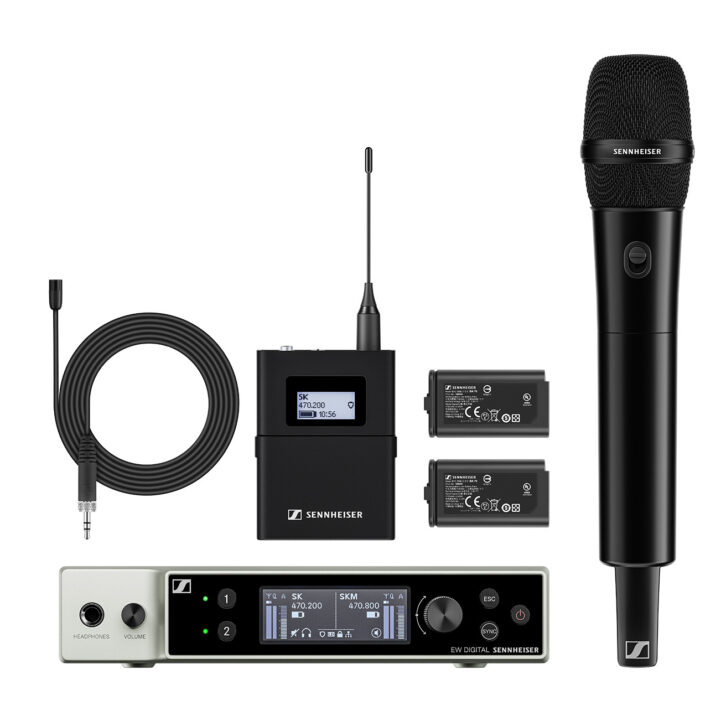 The award winning Sennheiser EW-DX digital UHF system employs equidistant channel spacing, auto scan, and AES-256 encryption. Bluetooth Low Energy (BLE) can be used for remote controlling the devices via a control app for iOS and Android. Link Density Mode gets more channels, up to 293, into the dedicated frequency band while Intelligent Switching Diversity enables the switching of antennas between audio frames to keep the RF transmission stable and free from audible artifacts. Transmitters can operate up to 12 hours on one battery charge and their function buttons give the user complete control of all parameters in including the e-link display. Dante integration can send the audio signals over large networks after very easy configuration. On the network, the system can be controlled through Sennheiser Control Cockpit and the all-metal case on the receiver models allow them to stand up to the rigors of the road.
The award winning Sennheiser EW-DX digital UHF system employs equidistant channel spacing, auto scan, and AES-256 encryption. Bluetooth Low Energy (BLE) can be used for remote controlling the devices via a control app for iOS and Android. Link Density Mode gets more channels, up to 293, into the dedicated frequency band while Intelligent Switching Diversity enables the switching of antennas between audio frames to keep the RF transmission stable and free from audible artifacts. Transmitters can operate up to 12 hours on one battery charge and their function buttons give the user complete control of all parameters in including the e-link display. Dante integration can send the audio signals over large networks after very easy configuration. On the network, the system can be controlled through Sennheiser Control Cockpit and the all-metal case on the receiver models allow them to stand up to the rigors of the road.
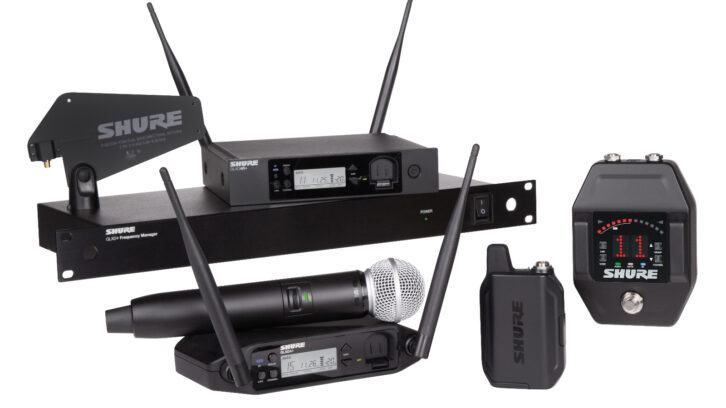 Just recently introduced, the Shure GLXD+ Dual Band Wireless System widens the RF spectrum on which it can operate with both 2.4GHz and now 5.8GHz bands. The new system sidesteps interference by automatically scanning for open channels and the receiver is available in tabletop, rack mount and guitar pedal options. All of these work with a huge variety of Shure mics and transmitters including headset, lavalier, and hand-held systems. The new lithium-ion SV904 battery can be charged directly on the tabletop and half-rack receivers or through a USB-C connector on the transmitter. A full charge can run the system for up to 12 hours while a 15-minute quick charge can provide 1.5 hours of use. Musical performers can easily switch between two or more transmitters linked to a single receiver, making on-stage transitions between instrumentation seamless. In optimal conditions, up to 16 systems can be used together.
Just recently introduced, the Shure GLXD+ Dual Band Wireless System widens the RF spectrum on which it can operate with both 2.4GHz and now 5.8GHz bands. The new system sidesteps interference by automatically scanning for open channels and the receiver is available in tabletop, rack mount and guitar pedal options. All of these work with a huge variety of Shure mics and transmitters including headset, lavalier, and hand-held systems. The new lithium-ion SV904 battery can be charged directly on the tabletop and half-rack receivers or through a USB-C connector on the transmitter. A full charge can run the system for up to 12 hours while a 15-minute quick charge can provide 1.5 hours of use. Musical performers can easily switch between two or more transmitters linked to a single receiver, making on-stage transitions between instrumentation seamless. In optimal conditions, up to 16 systems can be used together.
 Made by a long-time leader in innovative field sound, the new Sound Devices A20-RX is a dual channel true diversity receiver that features SpectraBand technology. This eliminates the need for purchasing different wireless receivers dedicated to specific frequency bands. It can tune among the UHF, STL, and ISM bands to find interference-free spectrum in any location and it has low-loss, brick-wall SAW filters to deliver excellent performance in noisy RF environments. The AutoAssign feature scans a user-designated tuning band and selects available frequencies for both channels. Current owners of the company’s A10-RX can have it converted to the A20-RX by sending the unit to Sound Devices for a hardware upgrade. The top-mounted LCD display shows all information needed and is clearly visible when the receiver is carried with the mixer in a field case. This model now joins the A20-Nexus true diversity wireless receiver that was introduced in November of 2022.
Made by a long-time leader in innovative field sound, the new Sound Devices A20-RX is a dual channel true diversity receiver that features SpectraBand technology. This eliminates the need for purchasing different wireless receivers dedicated to specific frequency bands. It can tune among the UHF, STL, and ISM bands to find interference-free spectrum in any location and it has low-loss, brick-wall SAW filters to deliver excellent performance in noisy RF environments. The AutoAssign feature scans a user-designated tuning band and selects available frequencies for both channels. Current owners of the company’s A10-RX can have it converted to the A20-RX by sending the unit to Sound Devices for a hardware upgrade. The top-mounted LCD display shows all information needed and is clearly visible when the receiver is carried with the mixer in a field case. This model now joins the A20-Nexus true diversity wireless receiver that was introduced in November of 2022.
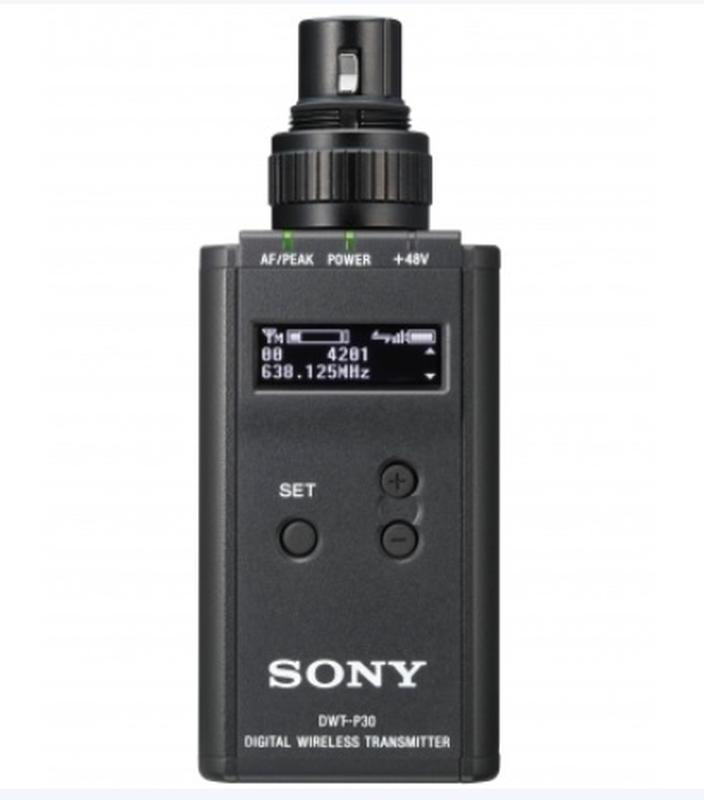 The Sony DWT-P30 plug-on transmitter makes it quick and easy to convert a favorite wired mic into a wireless device that uses the latest audio processing, encryption and RF transmission methods. It can operate within a bandwidth up to 148 MHz and it’s compatible with Sony Wireless Studio software for PC. Control of up to 82 transmitters is possible using the Cross Remote function combined with the RMU-01 remote control unit available separately. The Cross Remote function includes remote control for input attenuation, RF frequency selection, RF power output, audio low-pass cut-off frequency and transmitter Sleep Mode. For the big productions, the DWT-P30 supports high density simultaneous multi-channel operation. The RF output level is selectable between 2mW, 10mW, and 25mW.
The Sony DWT-P30 plug-on transmitter makes it quick and easy to convert a favorite wired mic into a wireless device that uses the latest audio processing, encryption and RF transmission methods. It can operate within a bandwidth up to 148 MHz and it’s compatible with Sony Wireless Studio software for PC. Control of up to 82 transmitters is possible using the Cross Remote function combined with the RMU-01 remote control unit available separately. The Cross Remote function includes remote control for input attenuation, RF frequency selection, RF power output, audio low-pass cut-off frequency and transmitter Sleep Mode. For the big productions, the DWT-P30 supports high density simultaneous multi-channel operation. The RF output level is selectable between 2mW, 10mW, and 25mW.
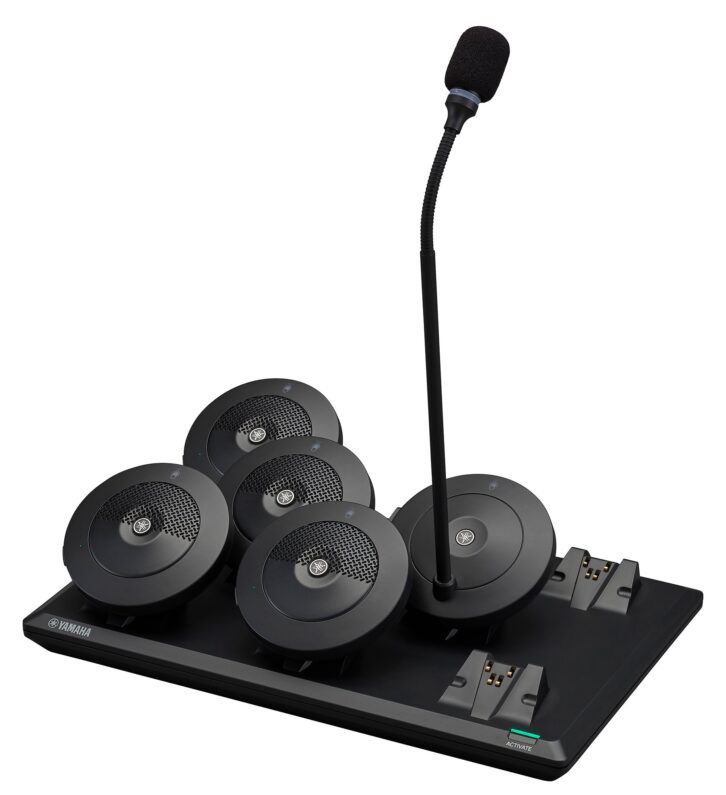 When wireless mics are mentioned, the first thing to come to mind may not be conferencing but, as its deployment continues, the Yamaha Unified Communications RM-W microphones are putting their mark on conferencing systems. Based on flexibility, the RM-W can be used as a boundary mic solution for small meeting rooms, or in a larger setting, the gooseneck configuration works well. Wireless operation works quite well for detailed but temporary installations. Anyone who has had to tape dozens of microphone cables down on the floor knows the value of a quick RF setup. Operating in the 1.9GHz band, the system is composed of the mics, the RM-WMT-8 access point and the charging station. The mics are available in 6in. gooseneck, 12in. gooseneck, omnidirectional boundary, and cardioid directional boundary versions. A single PoE+ network cable connection allows audio control via Dante.
When wireless mics are mentioned, the first thing to come to mind may not be conferencing but, as its deployment continues, the Yamaha Unified Communications RM-W microphones are putting their mark on conferencing systems. Based on flexibility, the RM-W can be used as a boundary mic solution for small meeting rooms, or in a larger setting, the gooseneck configuration works well. Wireless operation works quite well for detailed but temporary installations. Anyone who has had to tape dozens of microphone cables down on the floor knows the value of a quick RF setup. Operating in the 1.9GHz band, the system is composed of the mics, the RM-WMT-8 access point and the charging station. The mics are available in 6in. gooseneck, 12in. gooseneck, omnidirectional boundary, and cardioid directional boundary versions. A single PoE+ network cable connection allows audio control via Dante.



